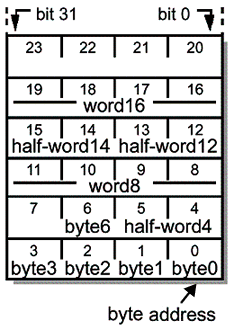Microprocessor Design and the ARM
Technical Details
Words, halfwords and bytes

The ARM is a load/store architecture in that only load and store instructions can access memory. All other instructions are register-to-register accesses. This speeds up overall operation as register accesses are much faster than memory accesses.
All ARM instructions are 32 bits wide and are subtle variations on the same regular formatting pattern. This makes decoding the instructions easier, simplifying some of the necessary circuitry and again speeding up the fetch-decode-execute cycle.
All input/output peripherals (such as printers, hard drive disks, and the network) are memory-mapped devices. There is also hardware support for high-bandwidth data transfer.
Most ARM processors are 32-bit architectures throughout. (Those that aren't are 64-bit architectures instead!) Thus they can address a maximum of 232 bytes (or 4 Gigabytes of memory). The word size is 32 bits, with half-words being 16 bits wide. Words are aligned on 4-byte boundaries; half words are aligned on even byte boundaries.
